| کد مقاله | کد نشریه | سال انتشار | مقاله انگلیسی | نسخه تمام متن |
|---|---|---|---|---|
| 2748009 | 1148945 | 2007 | 13 صفحه PDF | دانلود رایگان |

RésuméLa chirurgie de l'œsophage reste grevée d'une mortalité et d'une morbidité respiratoire postopératoire élevée. La prise en charge de cette procédure a néanmoins connu d'importantes évolutions tant épidémiologiques que médicales et chirurgicales. L'anesthésiste–réanimateur demeure un acteur majeur en raison de la prise en charge du patient à travers toutes les étapes entourant le geste chirurgical. L'évaluation préopératoire est facilitée par l'établissement de score d'évaluation, la meilleure appréhension des facteurs prédictifs de complications respiratoires ainsi que des effets secondaires des traitements néoadjuvants. Les procédures anesthésiques doivent permettre un sevrage respiratoire rapide du patient tout en préservant au mieux les fonctions respiratoires et hémodynamiques, garantes d'une réhabilitation rapide et de la viabilité du transplant digestif. La période postopératoire est marquée par l'intérêt de l'association réhabilitation respiratoire–analgésie péridurale thoracique. Les complications postopératoires dominées par les pneumopathies et les défauts de cicatrisation de la suture gastro-œsophagienne imposent une analyse multidisciplinaire. L'intérêt de la ventilation non invasive et les moyens de limiter les phénomènes inflammatoires postopératoires requièrent de futures investigations.
Oesophagectomy is still characterized by a high postoperative mortality and respiratory morbidity. Nevertheless, epidemiological, medical and surgical advances have improved the management of this surgical procedure. The anaesthesiologist influence is present at each level, from the preoperative evaluation to the management of postoperative complications. The preoperative period is improved by the use of assessment scores, the better knowing of respiratory risk factors and of the neoadjuvant therapy adverse effects. The main objective of the operative period is to ensure a rapid weaning procedure and stability of the respiratory and haemodynamic functions, warranting the anastomotic healing. The interest of the association between respiratory rehabilitation and thoracic epidural analgesia is highlighted in the postoperative period. The management of postoperative complications, mainly represented by respiratory failure and anastomotic leakages, requires a multidisciplinary analysis. The potential interest of non-invasive ventilation and of the modulation of postoperative inflammatory response needs further investigation.
Journal: Annales Françaises d'Anesthésie et de Réanimation - Volume 26, Issue 3, March 2007, Pages 229–241